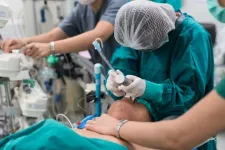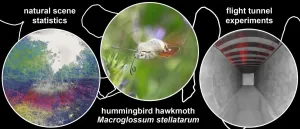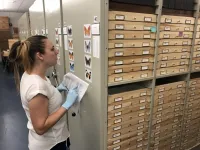Massey researcher finds new strategy for fighting brain cancer
2021-03-23
(Press-News.org) Most people relate cholesterol to heart health, but it is also a critical component in the growth and spread of brain cancer. VCU Massey Cancer Center researcher Suyun Huang, Ph.D., recently discovered how cholesterol becomes dysregulated in brain cancer cells and showed that the gene responsible for it could be a target for future drugs.
The mean survival of patients with the most common and aggressive type of brain cancer, glioblastoma multiforme (GBM), is 14 months. The need to find new, effective treatments is urgent and has driven Huang, a member of the Cancer Biology research program at Massey, to detail the workings of numerous genes, proteins, enzymes and other cellular components that contribute to brain cancer growth. Her studies are revealing a biological "roadmap" showing previously unknown functions of genes.
Huang's most recent study, published in the journal Nature Communications, pinpoints a gene called YTHDF2 as a crucial link in a chain leading to the development and growth of GBM. It works through a process set in motion by another gene with a well-established reputation for driving cancer progression, EGFR.
"These findings are exciting because we can potentially target YTHDF2 expression by using YTHDF2 small molecule inhibitors to control glioblastoma tumor growth and spread," says Huang, who is also a professor in the Department of Human and Molecular Genetics at VCU School of Medicine. "Our experiments also showed that we can stop the formation and growth of brain cancer cells by blocking YTHDF2 expression, so it could also be a powerful target for drug development."
EGFR is frequently overactivated in many aggressive cancers, including GBM. Huang's team found that EGFR drives the overexpression of TYHDF2, which then sustains increased cholesterol levels for the invasive growth and development of GBM cells through a process that degrades the LXRα and HIVEP2 genes. LXRα is known to regulate cholesterol levels within cells and HIVEP2 is involved in the development of brain tissue.
Huang's study is the first to describe this cell signaling cascade, and it helps fill in important parts of the "roadmap" leading to GBM. It is also the first study to show that N6-methyladenosine (m6A), a DNA modification found in nearly all cell-based life forms, plays a role in brain tumor growth and cholesterol metabolism. Huang's team found that the increase in YTHDF2 expression caused m6A modifications in the mRNA of LXRα and HIVEP2, which inhibited their functions.
Next, Huang and her collaborators plan to evaluate different YTHDF2 inhibitors and establish their effects in lab and animal models.
"EGFR inhibition and cholesterol regulation are both promising strategies for GBM treatment," says Huang. "Our study offers an exciting new approach that could potentially work hand-in-hand with these strategies to regulate and treat GBM."
INFORMATION:
Additional researchers involved in this study include Runping Fang, Ph.D., and Peng Li, M.D., both from the Department of Human and Molecular Genetics at VCU School of Medicine; Xin Chen, Ph.D., Sicong Zhang, Ph.D., Qing Guo, Ph.D., and Li Ma, Ph.D., all from MD Anderson Cancer Center; Youqiong Ye, Ph.D., from the University of Texas Health Science Center; and Zhongyu Zou, Ph.D., Chuan He, Ph.D., and Hailing Shi, Ph.D., all from the University of Chicago.
ELSE PRESS RELEASES FROM THIS DATE:
2021-03-23
Some 40% of critically ill patients who undergo tracheal intubation to support their breathing suffer a life-threatening complication, research from National University of Ireland Galway has revealed.
The study, published today in JAMA: The Journal of the American Medical Association, involved 2,964 critically ill men and women. It was carried out across 29 countries from 1 October 2018 to 31 July 2019 to determine the risk of adverse events arising from the invasive procedure.
John Laffey, Professor of Intensive Care Medicine at NUI Galway and Consultant in ...
2021-03-23
HOUSTON - (March 23, 2021) - Fish that dine on corals may pay it forward with poop.
It's an unexpected twist on coral reef symbiosis, said Rice University marine biologist Adrienne Correa, whose lab discovered coral predator feces are jam-packed with living symbiotic algae that corals depend on for survival. The discovery confirms that poop from coral-eating fish is an important environmental source of symbiotic dinoflagellate algae on coral reefs.
Correa said coral-eating predators are typically thought of as biting and weakening reef structures, thereby generating hiding spaces for other organisms and, ultimately, beach sand. In contrast, grazing fish that crop down bushy algae get the limelight for helping reefs maintain healthy coral ...
2021-03-23
Hummingbird hawkmoths are small insects that hover in the air like hummingbirds when drinking nectar from flowers. Dr. Anna Stöckl from the Biocentre of the Julius-Maximilians-Universität (JMU) Würzburg in Bavaria, Germany, is studying the visual performance of these insects. Dr. Stöckl and her doctoral student Ronja Bigge now present their latest findings in the journal Current Biology.
"To control their flight, hummingbird hawkmoths rely on optic flow in the lower half of their visual field," Ronja Bigge explains. Optic flow is the relative motion that the surrounding image casts on the animals' retinas when they fly. We experience this phenomenon ourselves when travelling by train ...
2021-03-23
DETROIT (March, 23, 2021) - Henry Ford physician, John Craig, M.D., is leading an international research effort to improve the multidisciplinary collaboration between otolaryngologists and dental providers around the globe when it comes to diagnosing odontogenic sinusitis (ODS).
ODS is an infectious condition of the paranasal sinuses that can occur from either dental infection or dental procedures involving the upper jaw. There are multiple ways that infection can spread from the teeth to sinuses, and in more severe scenarios, to the eye, brain, or rest of the body. It has been shown that the various clinicians ...
2021-03-23
Rural America is running short on physicians. This worries health experts who have linked limited access to primary care providers to major gaps in health outcomes for rural communities.
Addressing this issue is complicated, but new research from the University of Georgia suggests that understanding geographic trends in medical school applicants could help project where the future physician workforce is likely to practice.
Knowing a medical student's hometown is an important piece of the puzzle, said study author Donglan "Stacy" Zhang, because geography is known to predict where many new doctors choose to practice.
"More than 60% of doctors choose their practice location in ...
2021-03-23
The Bale Mountains in south-central Ethiopia are considered to be one of the most unique centers of endemism, with an extraordinary number of plants and animals that can only be found there. Numerous species are already known from this Afromontane high-elevation plateau, making it a biodiversity hotspot, but ongoing research continues to reveal the presence of so far unknown and undescribed organisms.
Zoologists END ...
2021-03-23
WASHINGTON--Exposure in the womb to a drug used to prevent miscarriage appears to raise the offspring's cancer risk decades later, especially for colorectal and prostate cancers, researchers have found. They will present the results of their new study Tuesday at ENDO 2021, the Endocrine Society's annual meeting.
Some adult children of women who received the drug, hydroxyprogesterone caproate (OHPC or 17-OHPC), during pregnancy in the 1950s and 1960s are now experiencing more than twice the odds of cancer, said the study's lead researcher, Caitlin Murphy, Ph.D., M.P.H., an assistant professor at the University of Texas Southwestern Medical Center in Dallas, Texas.
OHPC is a synthetic progestogen hormone that was ...
2021-03-23
By comparing the genetic diversity of butterflies in North America, researchers reporting in the journal iScience on March 23 found that the array of different evolutionary distinct groups of butterflies is particularly high in the deserts of Mexico and the southwestern United States. This may be an outcome of actively changing conditions in the Desert Southwest and more generally in the western portion of the continent.
"When you think of desert, you don't automatically jump to butterflies, but our results showed that this area is actually a really important hotspot for butterflies, even if it isn't for plants," says co-first author Chandra Earl, who recently received her PhD from the University of Florida. "Just because butterflies are closely tied to their host plants doesn't ...
2021-03-23
WASHINGTON, March 23, 2021 -- 5G, or the fifth-generation technology standard for broadband cellular networks, is touted as having finally arrived for ultrafast download speeds, an end to dropped calls and buffering, and greater connectivity to advance autonomous vehicle development, remote surgery, and the Internet of Things.
In truth, 5G technology adoption is still in its early stages, according to Michael Hill, technical director of Skyworks Solutions, a California-based advanced-semiconductor company. In their paper, published in Applied Physics Letters, by AIP Publishing, Hill and his colleagues provide an overview on nascent 5G ...
2021-03-23
WASHINGTON, March 23, 2021 -- Scientists have been working for the past year to find ways to curb the effects of the COVID-19 pandemic. Though it is outside their typical realm of study, physicists have been playing an important role in many aspects of research about the pandemic and its impact on people.
Particle physicists' keen understanding of gas handling systems positioned them at the forefront for pioneering low-cost, mass-producible ventilators to help address the worldwide shortage. Led by Cristian Galbiati, professor of physics at Princeton University and the Gran Sasso Science Institute, an international, interdisciplinary team called the Mechanical Ventilator Milano ...
LAST 30 PRESS RELEASES:
[Press-News.org] Massey researcher finds new strategy for fighting brain cancer







